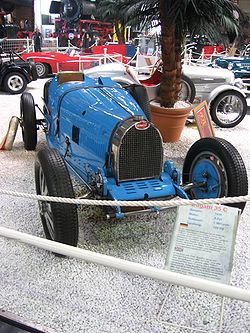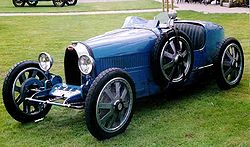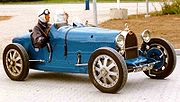
Bugatti Type 35
Encyclopedia

Bugatti
Automobiles E. Bugatti was a French car manufacturer founded in 1909 in Molsheim, Alsace, as a manufacturer of high-performance automobiles by Italian-born Ettore Bugatti....
racing models. Its version of the Bugatti arch-shaped radiator that had evolved from the more architectural one of the Bugatti Type 13
Bugatti Type 13
The Type 13 was the first real Bugatti car. Production of the Type 13 and later Types 15, 17, 22, and 23, began with the company's founding in 1910 and lasted through 1920 with 435 examples produced. Most road cars used an 8-valve engine, though five Type 13 racers had 16-valve heads, one of the...
Brescia, was to become the one that the marque is most known for though even in the ranks of the various Type 35s there were variations on the theme.
The Type 35 was phenomenally successful, winning over 1,000 races in its time. It took the Grand Prix
Grand Prix motor racing
Grand Prix motor racing has its roots in organised automobile racing that began in France as far back as 1894. It quickly evolved from a simple road race from one town to the next, to endurance tests for car and driver...
World Championship in 1926 after winning 351 races and setting 47 records in the two prior years. At its height, Type 35s averaged 14 race wins per week. Bugatti organized the Targa Florio
Targa Florio
The Targa Florio was an open road endurance automobile race held in the mountains of Sicily near Palermo. Founded in 1906, it was the oldest sports car racing event, part of the World Sportscar Championship between 1955 and 1973...
as a special spotlight for this car, and it claimed victory there for five consecutive years, from 1925 through 1929.
Type 35

Lyon
Lyon , is a city in east-central France in the Rhône-Alpes region, situated between Paris and Marseille. Lyon is located at from Paris, from Marseille, from Geneva, from Turin, and from Barcelona. The residents of the city are called Lyonnais....
on August 3, 1924, used an evolution of the 3-valve
Multi-valve
In automotive engineering a multi-valve or multivalve engine is one where each cylinder has more than two valves. A multi-valve engine has better breathing and can operate at higher revolutions per minute than a two-valve engine, delivering more power.- Multi-valve rationale :A multi-valve design...
2.0 L (1991 cc/121 in³) overhead cam straight-8
Straight-8
The straight-eight engine or inline-eight engine is an eight-cylinder internal combustion engine with all eight cylinders mounted in a straight line along the crankcase...
engine first seen on the Type 29. Bore was 60 mm and stroke was 88 mm as on many previous Bugatti models. 96 examples were produced.
This new powerplant featured five main bearings with an unusual ball bearing
Ball bearing
A ball bearing is a type of rolling-element bearing that uses balls to maintain the separation between the bearing races.The purpose of a ball bearing is to reduce rotational friction and support radial and axial loads. It achieves this by using at least two races to contain the balls and transmit...
system. This allowed the engine to rev to 6000 rpm, and 90 hp (67 kW) was reliably produced. Solid axles with leaf spring
Leaf spring
Originally called laminated or carriage spring, a leaf spring is a simple form of spring, commonly used for the suspension in wheeled vehicles...
s were used front and rear, and drum brake
Drum brake
A drum brake is a brake in which the friction is caused by a set of shoes or pads that press against a rotating drum-shaped part called a brake drum....
s at back, operated by cables, were specified. Alloy wheel
Alloy wheel
Alloy wheels are automobile wheels which are made from an alloy of aluminium or magnesium. They are typically lighter for the same strength...
s were a novelty, as was the hollow front axle for reduced unsprung weight
Unsprung weight
In a ground vehicle with a suspension, the unsprung weight is the mass of the suspension, wheels or tracks , and other components directly connected to them, rather than supported by the suspension...
. A second feature of the Type 35 that was to become a Bugatti trademark was passing the springs through the front axle rather than simply U-bolting them together as was done on their earlier cars.
A rare version was de-bored (to 52 mm) for a total displacement of 1.5 L (1494 cc/91 in³).
Dimensions:
- Length: 3680 mm (144.9 in)
- Width: 1320 mm (52 in)
- Wheelbase: 2400 mm (94.5 in)
- Track: 1200 mm (47.2 in)
- Weight: 750 kg (1650 lb)

Type 35A
A less expensive version of the Type 35 appeared in May, 1925. The factory's Type 35A name was ignored by the public, who nicknamed it "Tecla" after a famous maker of imitation jewelry. The Tecla's engine used three plain bearings, smaller valves, and coil ignition like the Type 30. While this decreased maintenance requirements, it also reduced output. 139 of the inexpensive Type 35As were sold.
Type 35C
The Type 35C featured a roots typeRoots type supercharger
The Roots type supercharger or Roots blower is a positive displacement lobe pump which operates by pumping fluids with a pair of meshing lobes not unlike a set of stretched gears. Fluid is trapped in pockets surrounding the lobes and carried from the intake side to the exhaust...
supercharger
Supercharger
A supercharger is an air compressor used for forced induction of an internal combustion engine.The greater mass flow-rate provides more oxygen to support combustion than would be available in a naturally aspirated engine, which allows more fuel to be burned and more work to be done per cycle,...
, despite Ettore Bugatti
Ettore Bugatti
right|thumb|Ettore Bugatti in 1932Ettore Arco Isidoro Bugatti was an Italian-born and French naturalized citizen automobile designer and manufacturer....
's disdain for forced induction
Forced induction
Forced induction is the process of compressing air on the intake of an internal combustion engine . A forced induction engine uses a gas compressor to increase the pressure, temperature and density of the air...
. Output was nearly 128 hp (95 kW) with a single Zenith carburettor. Type 35Cs won the 1928 and 1930 French Grand Prix
French Grand Prix
The French Grand Prix was a race held as part of Fédération Internationale de l'Automobile's annual Formula One automobile racing championships....
. Fifty examples left the factory.
Type 35T
For 1926, Bugatti introduced a special model for his new Targa FlorioTarga Florio
The Targa Florio was an open road endurance automobile race held in the mountains of Sicily near Palermo. Founded in 1906, it was the oldest sports car racing event, part of the World Sportscar Championship between 1955 and 1973...
race. Called the Type 35T officially, it soon became known as the Targa Florio. Engine displacement was up to 2.3 L (2262 cc/138 in³) with a longer 100 mm stroke. Grand Prix rule changes limiting capacity to 2.0 L limited the appeal of this model at the time with just thirteen produced.

Type 35B
The final version of the Type 35 series was the Type 35B of 1927. Originally named Type 35TC, it shared the 2.3 L engine of the Type 35T but added a large supercharger like the Type 35C. Output was 138 hp (102 kW), and 45 examples were made. A Type 35B won the 1929 French Grand PrixFrench Grand Prix
The French Grand Prix was a race held as part of Fédération Internationale de l'Automobile's annual Formula One automobile racing championships....
.


Type 37
The Type 35 chassis and body were reused on the Type 37 sports car. Fitted with a new 1.5 L (1496 cc/91 in³) straight-4Straight-4
The inline-four engine or straight-four engine is an internal combustion engine with all four cylinders mounted in a straight line, or plane along the crankcase. The single bank of cylinders may be oriented in either a vertical or an inclined plane with all the pistons driving a common crankshaft....
engine, 290 Type 37s were built. This engine was an SOHC 3-valve
Multi-valve
In automotive engineering a multi-valve or multivalve engine is one where each cylinder has more than two valves. A multi-valve engine has better breathing and can operate at higher revolutions per minute than a two-valve engine, delivering more power.- Multi-valve rationale :A multi-valve design...
design and produced 60 hp (44 kW). The same engine went on to be used in the Type 40.
The supercharged Type 37A accounted for 67 of the production slots. Engine output was up to 80 to 90 hp (59 to 67 kW). It also had larger shrouded brake drums.
Type 39
The Type 39 was basically identical to the Type 35C except for its engine. This was modified to be smaller at 1.5 L (1493 cc/91 in³) with a shorter-stroked crankshaft. This brought stroke down from 88 mm to 66 mm, and a mix of regular and ball bearings were used. Ten examples were produced.An odd 1.1 L (1092 cc/66 in³) version was also created by reducing the bore of the engine to 51.3 mm.

